Use 'Print preview' to check the number of pages and printer settings.
Print functionality varies between browsers.
Printable page generated Saturday, 22 November 2025, 1:30 PM
Hygiene and Environmental Health Module: 17. Water Pollution and its Control
Study Session 17 Water Pollution and its Control
Introduction
In the previous study sessions you have learnt about the importance of protecting water from contamination and the techniques for undertaking a sanitary survey of drinking water. In this study session, you will learn about the sources and types of water pollution, the public health impacts and indicators of water pollution and approaches to the control of pollution.
Learning Outcomes for Study Session 17
When you have studied this session, you should be able to:
17.1 Define and use correctly all of the key words printed in bold. (SAQ 17.1)
17.2 Describe the sources and types of water pollution. (SAQ 17.2)
17.3 Explain some techniques for the control of water pollution. (SAQ 17.3)
17.4 Describe techniques for taking samples from drinking water sources.(SAQ 17.4)
17.1 Sources of water pollution
Water is a good solvent. This is the reason why many different chemical substances are found dissolved in water. Gases in the atmosphere will dissolve in rainwater as it passes through the air. By the time water reaches a stream or river, it will contain a variety of chemical compounds dissolved within it from the air and from the rocks and soil through which it has percolated. These compounds may be completely harmless, naturally occurring substances, but they may also include pollutants.
Pollution can be defined as the introduction into the natural environment (air, water or land) of substances (pollutants) that are liable to cause harm to human health or to animals, plants and the wider environment. Water pollution occurs when a river, lake or other body of water is adversely affected due to the addition of pollutants (Figure 17.1).
Water quality can be affected by pollution from point sources and non-point sources. Point sources are identifiable points or places, such as a pipe or channel, which discharge directly into a body of water. This might be from wastewater treatment plants, factories and industrial plants, latrines, septic tanks or piped discharge from barnyards and other places where livestock are confined. Non-point sources are those where pollution arises over a wider area and it is often difficult to locate the exact place of origin. For example, fertiliser or pesticide washed from a field by rain may seep into a river or stream at many places both on the surface and through the soil. Pollution from non-point sources, also known as diffuse pollution, contributes most of the contaminants in rivers and lakes. Other non-point sources are pollution from construction sites and other land disturbances. The problems in identifying the exact point of origin make non-point sources much more difficult to control.
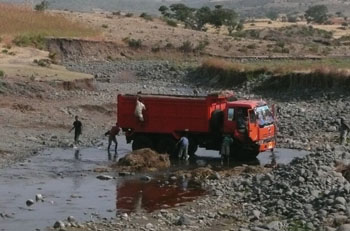
Look at Figure 17.1. What pollutants are likely to be washed into the river from the lorry? Is this a point source or non-point source of pollution?
Dust and dirt from the lorry will be washed into the river. Some oil and fuel may also be washed from the underside. The lorry is the single source of pollution so this is an example of a point source.
17.2 Types of water pollutants
17.2.1 Sediments and suspended solids
Sediments consist of fine particles of mostly inorganic material such as mud and silt washed into a stream as a result of land cultivation and construction. They may also arise from demolition and mining operations where these activities take place. The presence of solid particulate material suspended in the flowing water is the reason why many rivers look brown in colour, especially in the rainy season. The particles are called suspended solids while they are carried (suspended) in flowing water. When they settle to the bottom, they are called sediments.
Organic matter means anything that is derived from living organisms, i.e. all plants and animals. Inorganic matter has a mineral, rather than biological, origin meaning it comes from rocks and other non-living sources.
Large quantities of inorganic matter, in the form of suspended solids, may reduce light penetration into the water which can affect the growth of plants. Sediments may even suffocate organisms on the river bed. River water may also contain organic matter, such as human and animal wastes, which can deplete (reduce) the oxygen in the water if the river is slow-flowing (see Box 17.1). This can lead to anaerobic conditions which may create unsightly conditions and cause unpleasant odours.
Box 17.1 Oxygen in water
Many aquatic (water living) organisms depend on oxygen dissolved in the water to survive. Aquatic animals include fish, amphibians and many invertebrate species such as insect larvae, snails and worms. Their supply of oxygen in the water is maintained from atmospheric oxygen in the air above the water and from oxygen produced by green aquatic plants by the process of photosynthesis. Fast-flowing, turbulent water will be aerated (gain oxygen) more than still water because the boundary between air and water is more active.
If organic pollutants such as human and animal wastes are released into a water body, bacteria will use the waste as food and break it down into simpler, less harmful substances. As they do this, the bacteria will use up the dissolved oxygen from the water. This is called deoxygenation. If the quantity of organic pollution is high, then all the oxygen from the water may be used up leading to anaerobic (without oxygen) conditions. This is unlikely in a river where the water is moving but can happen in lakes or slow-flowing channels.
Inorganic solids, such as mud and silt, do not have this effect because they are inert (stable and inactive) and cannot be used as food by bacteria.
17.2.2 Nutrients
Phosphorus and nitrogen are common pollutants generated from residential areas and agricultural runoff, and are usually associated with human and animal wastes or fertiliser. Nitrogen and phosphorus are plant nutrients required by plants to grow. They are spread on farmland in the form of fertilisers. Rain washes these nutrients into rivers, streams and lakes. If the nutrients are present in large quantities, they can encourage excess plant growth in the water causing the phenomenon known as an algal bloom, which means a sudden increase in the population of microscopic algae. If a water body has high nutrient levels it is said to be eutrophic; the process is called eutrophication. The main problem of eutrophication is that the suddenly increased population of aquatic plants can die off equally quickly. The decay of the plant material by bacteria can cause deoxygenation of the water.
Can you think of a reason why eutrophication is more likely to be a problem in lakes than in rivers?
Because flowing water in a river will disperse the nutrients; in the still water of a lake, the nutrients will accumulate.
17.2.3 Biological pollutants
Biological pollutants are microorganisms (bacteria, viruses, protozoa and helminths) that are harmful to humans and other forms of life. Infectious diseases caused by biological pollutants, such as typhoid and cholera, are the most common and widespread public health risks associated with drinking water.
Microorganisms may get into water with dust from the air as rain falls, and when water passes through soil which is polluted with human and animal wastes. The contamination of water supplies with raw sewage (human and domestic wastes generated from residential areas) is the most common route for biological pollutants to enter water.
When contaminated river water moves downstream it is possible that any pollutant will be diluted as more water flows in and so increases the total volume of water in the river. This dilution may be enough to reduce the contaminants sufficiently to minimise the possible health effects but this process may not work for all pathogens.
Bacteria
Many different types of bacteria are found in fresh water. They are not all pollutants because many are not harmful in any way and play a valuable role in the natural breakdown of organic matter and the cycling of nutrients. Other bacteria, however, as you have learnt in other sessions, are pathogens, and are the cause of many waterborne diseases. The presence of faecal coliform bacteria in drinking water, and E.coli in particular, can indicate a possible presence of harmful, disease-causing organisms.
Viruses
Enteric (intestinal) viruses are produced by infected persons and excreted in faeces. Viral contamination may come from sewage effluent discharged into a river or from open defecation by an infected person which may be washed by rainwater to a river or stream. Some enteric viruses are resistant to chlorination. The common waterborne viruses are polio, hepatitis A and rotavirus. The presence of any enteric virus in water bodies can be taken as an indication of the possible presence of other harmful viruses.
Protozoa
There are several protozoa that can be discharged into water bodies from infected persons. For example, Cryptosporidium and Giardia are common problems in rural parts of Ethiopia.
What type of household water treatment is appropriate for removing protozoa from drinking water?
A home sand filter is appropriate for removing protozoa from drinking water. The layers of sand and gravel will trap the protozoa.
Helminths
Helminths or parasitic worms can also cause ill health in humans. Infection occurs through ingestion of the helminth eggs which may be present in food. For example, helminth eggs may be present in the meat of cattle grazing on land contaminated by faeces.
Can you think of an example of a helminth infection that is transmitted by polluted water?
Guinea worm (dracunculiasis) is transmitted by drinking water that contains copepods infected by the larvae of the worm.
17.2.4 Chemical pollutants
Heavy metals
Arsenic, copper, lead, mercury and cadmium are chemical pollutants that may be found in lakes, rivers and groundwater. Fortunately these are not common problems in rural Ethiopia. These heavy metals can harm aquatic organisms and humans. Farmers who use river water polluted by urban wastes for irrigation of fruits and vegetables may find their crops affected by the accumulation of these chemicals.
Pesticides
Pesticides include insecticides, herbicides and fungicides. There are several thousand different types in use and almost all of them are possible causes of water pollution. For example, DDT, malathion, parathion, delthametrine and others have been sprayed in the environment for long periods of time for the control of disease vectors such as mosquitoes, and to control the growth of weeds and other pests.
17.2.5 Types of pollutant defined by their source
Pollutants from certain sources may be a mixture of the types described above and therefore need a separate category because they combine several possible impacts. Municipal wastewater and agricultural wastes are in this category.
Municipal wastewater is generated from residential areas and often contains high concentrations of organic matter, phosphorus and nitrogen, pesticides, toxic chemicals, salts, inorganic solids such as silt, as well as pathogenic bacteria and viruses.
Agricultural wastes are generated from livestock and poultry farming and from growing crops. They can be the source of many organic and inorganic pollutants in surface waters and groundwater. Agricultural wastes include sediment from erosion of cropland, and phosphorus and nitrogen compounds that originate in animal wastes and commercial fertilisers. Animal wastes require oxygen to be broken down in water bodies and can also harbour pathogenic organisms. The extensive use of fertilisers and pesticides in agricultural regions means that both surface and groundwater are affected by these pollutants.
What is likely to happen when fertiliser is washed off agricultural fields into a lake?
Fertiliser contains nitrate and phosphate, which are plant nutrients. If these are washed into a lake the water will become eutrophic (high concentrations of nutrients).
17.3 Public health impacts of water pollution
Waterborne infectious diseases are transmitted primarily through contamination of the water sources with excreta of humans and animals who are either active cases or carriers of disease. Carriers do not show any signs of disease although they have disease-causing agents in their body that can be transferred to others; active cases are people who are displaying visible signs of disease. Use of contaminated water for drinking or cooking, or contact with contaminated water during washing or bathing, may result in infection.
The dose or amount ingested that is necessary to cause illness depends on the type of pathogen. Exposure to a single pathogenic organism does not always result in infection and disease. Sometimes many pathogens, perhaps several hundred, must be ingested to cause infection. The minimum infectious dose also varies with the age, health, nutritional and immunological status of the exposed individual. Infants and young children, people who are debilitated, people who are living in unsanitary conditions, people who are sick and the elderly are at greatest risk of waterborne diseases.
17.4 Indicators of water pollution
The physical, chemical and biological characteristics of water are changed when the water is contaminated with different pollutants. Water is colourless, odourless and tasteless, as you know, but when it is polluted with physical and chemical pollutants the water may have colour, odour and taste.
If water is completely clear and has no colour or odour, is it safe to drink?
Not necessarily, because it may contain microorganisms or dissolved chemicals that cannot be seen.
To know whether water is polluted with specific bacterial contaminants, samples should be taken and sent to a laboratory for analysis. As noted in Study Session 16, E.coli is the standard indicator organism for faecal contamination of water and for the possible presence of faecal pathogens. For water intended for drinking, the World Health Organization (WHO) recommends that E.coli must not be detectable in any 100 ml sample. In most developing countries like Ethiopia the priority is to get from ‘bad’ quality (more than 1,000 faecal coliforms per 100 ml) to ‘moderate’ quality (less than 10 faecal coliforms per 100 ml). ‘Good’ quality is classed as zero faecal coliforms per 100ml.
17.5 Effects of pollution on water sources
17.5.1 Streams and rivers
Streams and rivers are not only potential water sources for humans, they are also important aquatic habitats for many plants and animals. Pollution can have a damaging effect on aquatic ecosystems (see Box 17.1) as well as potentially on human health.
Box 17.1 Aquatic ecosystems
Ecosystem was defined in Study Session 2. It means a community of living organisms that interact with each other, plus the environment in which they live and with which they also interact. An ecosystem therefore includes plants, animals and microorganisms and their physical environment which may be land, trees, soil, ocean, freshwater, etc., and also includes the relationships between all these components. Aquatic ecosystems can be categorised as marine ecosystems in the ocean, and freshwater ecosystems in rivers, lakes and other surface water bodies (Figure 17.2).
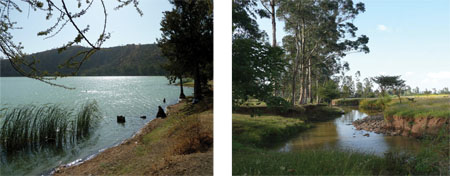
The effect of pollution on streams and rivers depends on the type of pollutant. Some substances are acutely toxic to aquatic plants and animals and will cause dead zones downstream from the pollutant source in which no living organism is found. Other pollutants are health concerns to humans, but have little impact on aquatic communities.
One of the most common types of freshwater pollutant is biodegradable organic material. When a high concentration of organic material such as raw sewage (human excreta) is discharged into a stream, the levels of dissolved oxygen in the water may fall so low that the water is completely deoxygenated.
Why does the dissolved oxygen level fall if organic material pollutes a river?
Bacteria that break down the organic material require oxygen to survive. They use the oxygen dissolved in the water causing the level to fall.
17.5.2 Lakes
The effect of pollution on lakes differs in several respects from the effect on rivers. Water movement in lakes is slower than in rivers so re-aeration is slower. The reduction in flow rate as a stream enters a lake also causes sediments to settle out of the water and slowly accumulate on the bottom of the lake. Some pollutants are bound to the solid particles and will therefore also accumulate in the sediment.
17.5.3 Groundwater
Water that moves through the soil will, to some extent, be purified naturally. However, this is not always true because soil cannot remove all pollutants. Many soils have the ability to remove certain types of pollutants, including phosphorus, heavy metals, bacteria and suspended solids. However, pollutants that dissolve in water, like nitrate and ammonia from fertilisers and animal wastes, can pass through soils into the groundwater. This may cause high concentrations of pollutants in local drinking water wells. Leaking from underground storage tanks, solid waste landfills, improperly stored hazardous waste, careless disposal of solvents and hazardous chemicals on ground surfaces are other potential sources of groundwater pollution.
Why is it important for pit latrines to be located at least 15 metres from the nearest well and at a lower level?
Because, depending on the local geology, liquid from the pit could flow through rock and soil into the groundwater and to the well. If the latrine is at a lower level than the well, the effect of gravity will make groundwater contaminated from the pit flow away from the well.
17.6 Problems of using polluted water
The impacts of using contaminated water for drinking have been discussed in other study sessions. However, we use water for other purposes that can also be affected by water pollution such as irrigation, for livestock and for recreation.
Contaminants in irrigation water (Figure 17.3) may accumulate in the soil and, after a period of years, render the soil unfit for agriculture. Even when the presence of pesticides or pathogenic organisms in irrigation water does not directly affect plant growth, it may potentially affect the acceptability of the agricultural product for sale or consumption.
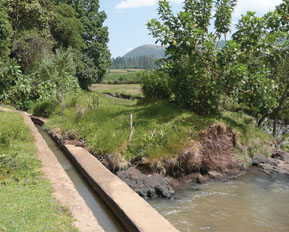
Poor quality water can affect livestock by causing death, sickness or impaired growth. Some substances, or their degradation products, present in water used for livestock may occasionally be transmitted to humans. The purpose of good quality water used for livestock watering is, therefore, to help protect both the livestock and the consumer.
Contaminated water also has health problems for those who swim in it. They may become ill if the water is contaminated with faecal material or with microorganisms that could cause gastrointestinal illness or ear, eye or skin infections. For example, schistosomiasis is contracted simply by swimming or standing in water that is contaminated with the Schistosoma worm.
17.7 Control of water pollution
The control of pollution should ideally take place at the point of generation, or, in other words, it should be prevented at source. As you have learned from the sanitary survey, you should look out for possible sources of pollutants in your locality.
The control of excess nutrients is an important issue both from a public health perspective and to keep natural waters free from eutrophication. An increasing proportion of water pollution originates from diffuse (non-point) sources, such as agricultural use of fertilisers. Farmers may need guidance on good agricultural practices that will help reduce water pollution from agriculture. For example, the amount of fertiliser used and the timing of its application can make a significant difference.
Imagine you are a farmer thinking about the best time to apply fertiliser to your field. Would it be better to spread the fertiliser before or after heavy rain?
It would be better after the rain because if the fertiliser was spread beforehand then much of it would probably be washed away. This would not only pollute the nearest river but would, of course, also reduce the effectiveness on the crop.
Pollution prevention is best achieved by ensuring that each potential point source is properly sited, designed, constructed and managed; the aim being to contain the pollutants and prevent their uncontrolled release to the environment. Sources of pollution should be sited as far from watercourses as possible (at least 15 m away) and below any water sources on the site. Appropriate use of excreta disposal, solid waste disposal and animal waste disposal will help prevent contamination of both surface and groundwater. (You will learn more about this in the waste management study sessions that follow.)
Springs usually become contaminated when latrines, animal yards, sewers, septic tanks, cesspools or other sources of pollution are located on higher land nearby. In areas with limestone rocks, contaminated material can enter the water-bearing channels in the rock and descend through cracks and holes or other large openings and may be carried along with groundwater for long distances. Other rock types can have a similar effect so it is important to have knowledge of the local geology to assess the probability of groundwater contamination.
What are the key preventive measures that will help to ensure that spring water is of a consistently high quality?
The key measures are:
- Dig a diversion ditch above the spring that will take surface water away from it.
- Build a fence to keep animals away from the spring.
- Design and build a protection box for the spring that will prevent contamination.
- Monitor the condition of the spring and the quality of the water regularly.
Monitoring of the quality of spring water and other sources would be done by you and environmental health experts.
For rainwater harvesting, pollution control means proper maintenance of the roof and gutters and careful cleaning at the beginning of every wet season. Some form of mesh should be placed between the guttering and the pipe that leads to the storage tank to prevent the entry of coarse debris; it then becomes important to clean the screen regularly to prevent blockage. The worst fouling of roofs occurs when they are situated under trees in which birds roost. A rainwater storage tank should be completely covered and well maintained.
The catchment area of the water source is the total area of surrounding land that slopes towards the source. Water can become polluted from sources in the catchment even though they may be some distance away. Ideally, the whole catchment area should be protected to avoid pollution and erosion. Preserving the vegetation in the surrounding area can help protect the spring from pollution and from siltation caused by soil erosion.
17.8 Sampling methods for bacteriological testing
During the course of an investigation into a disease outbreak or as part of routine monitoring, you may be required to take water samples to be sent for microbiological or chemical analysis. It is important that samples are taken carefully and correctly to ensure they can be used for an accurate assessment of the condition of the source. When water samples are collected for analysis, you should take care to ensure that there is no external contamination of the samples. Glass bottles, rather than plastic, are best used for sampling. Both bottles and stoppers (caps) must be sterilised. Bottles should be clearly labelled with the place where the sample was taken and the date. You should be able to obtain sample bottles from your regional public health microbiology laboratory or your local environmental health office.
You may need to take water samples from a tap, river, lake, water tank or dug well, and each has a slightly different procedure to follow.
17.8.1 Sampling procedure from a tap or pump outlet
To obtain a representative sample of water, you should carefully follow the sampling procedure described below and illustrated in Figure 17.4. The steps are:
- Clean the tap/outlet using a clean cloth to remove any dirt.
- Open the tap and turn on at maximum flow and let the water run for 1 to 2 minutes; then turn it off.
- Sterilise the tap for a minute with the flame from a cigarette lighter, or an ignited alcohol-soaked cotton-wool swab.
- Open the tap again and allow the water to flow for 1 to 2 minutes at a medium flow rate.
- Open a sterilised bottle by carefully unscrewing the cap or pulling out the stopper.
- Immediately hold the bottle under the water jet and fill.
- While filling the bottle, hold the cap face downwards to prevent entry of dust, which may contaminate the sample.
- Place the stopper in the bottle or screw on the cap. A small air space should be left to make shaking before analysis easier.
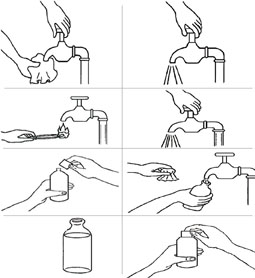
17.8.2 Sampling procedure from a watercourse or reservoir
The steps are:
- Open the sterilised bottle as described above.
- Fill the bottle by holding it by the lower part and submerging it to a depth of about 20 cm, with the mouth facing slightly upwards. If there is a current, the bottle mouth should face towards the current (Figure 17.5).
- The bottle should then be capped or stoppered.
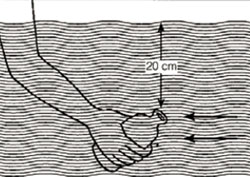
17.8.3 Sampling procedure from dug wells and similar sources
The steps are:
- Prepare the bottle with a piece of string and attach a clean weight to the sampling bottle. (Figure 17.6)
- Take a 20 m length of clean string rolled around a stick and tie it to the bottle string.
- Open the bottle as described above.
- Lower the bottle, weighed down by the weight, into the well, unwinding the string slowly. Do not allow the bottle to touch the sides of the well.
- Immerse the bottle completely in the water and lower it well below the surface but without hitting the bottom or disturbing any sediment.
- Raise the bottle when it is judged to be filled, rewind the string on the stick to bring up the bottle. If the bottle is completely full, discard some water to provide an air space.
- Stopper or cap the bottle as described previously.
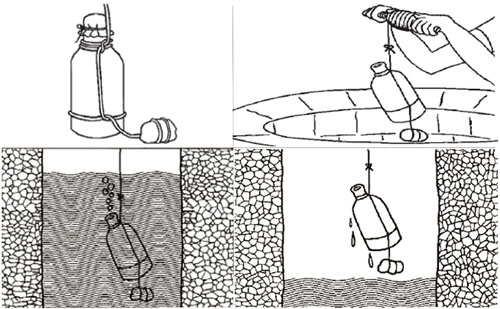
Summary of Study Session 17
In Study Session 17, you have learned that:
- Water pollution is any contamination of water with substances that are detrimental to human, plant or animal health.
- Water pollutants can be of point or non-point source depending on whether substances are discharged directly into a body of water or indirectly from diffuse sources.
- There are various types of water pollution including organic and inorganic sediments, nutrients, biological and chemical pollutants.
- Biological pollutants include bacteria, viruses, protozoa and helminths. They enter the water from human faeces from infected people and are the cause of many water-related diseases.
- The effects of water pollution on an aquatic ecosystem depend on the type of pollutant and the type of water body.
- Ideally pollution control should take place at the point of origin, i.e. pollution should be prevented at source.
- There are specified procedures to follow when taking a water sample for analysis to ensure the sample is representative.
Self-Assessment Questions (SAQs) for Study Session 17
Now that you have completed this study session, you can assess how well you have achieved its Learning Outcomes by answering the following questions. Write your answers in your Study Diary and discuss them with your Tutor at the next Study Support Meeting. You can check your answers with the Notes on the Self-Assessment Questions at the end of this Module.
SAQ 17.1 (tests Learning Outcome 17.1)
Match the definitions with the corresponding words below.
Two lists follow, match one item from the first with one item from the second. Each item can only be matched once. There are 4 items in each list.
A foreign component in a substance
High levels of plant nutrients in water
The source of pollutants is visible at time of discharge
Diffuse source of pollution
Match each of the previous list items with an item from the following list:
a.Contaminant
b.Point source pollution
c.Eutrophication
d.Non-point source pollution
- 1 = a,
- 2 = c,
- 3 = b,
- 4 = d
SAQ 17.2 (tests Learning Outcome 17.2)
In the village of Felashit, there are two dug wells. Some villagers fetch water from the eastern well and another group fetches water from the well dug on the western part of the village. The residents in the eastern part of the village are suffering from an outbreak of diarrhoea. What might be the possible reasons for this?
Answer
Assuming there were no other differences to consider than their respective sources of water, it would seem likely that the eastern well has become contaminated. The possible sources may be point sources from a latrine, if there is one located above the dug well or from an overflow of the latrine into the dug well. Possible non-point sources might be open defecation around the village causing contamination of the well after rain. Further investigation would be needed to identify the cause for certain.
SAQ 17.3 (tests Learning Outcome 17.3)
Suppose you are working in a village and the community members want to know how they should protect their water source from pollution. What pollution control techniques would you tell them about?
Answer
Your answer will depend on the local situation but the same general rules will apply anywhere. You should advise them to be aware of the importance of proper disposal of human excreta, which means avoiding open defecation and constructing latrines that are at least 15 m away from water sources and at a lower level; appropriate disposal of animal wastes; appropriate disposal of solid waste; and the possibility of pollution from agricultural activities such as spreading fertiliser. In some locations there may also be potential hazards from industry, roads and other sources of pollution.
SAQ 17.4 (tests Learning Outcome 17.4)
Imagine that you have been asked to take water samples from the two wells in Felashit village for chemical and microbiological analysis. What would you do to ensure that accurate samples were taken?
Answer
It would be important to ensure there was no contamination of the samples during or after sampling and that they were a representative sample of the water in the wells. The sampling bottles and their stoppers must be sterilised. The sample bottles for the two wells would need to be clearly labelled so that there was no danger of confusion between them. The sample should be taken by weighting the bottle and lowering it on a string into the well, lowering it below the surface of the water but not hitting the bottom, waiting until it is filled, then raising the bottle and capping it immediately.